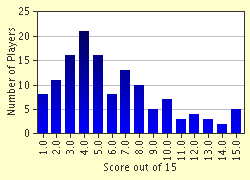Quiz Answer Key and Fun Facts
1. The British-French war in North America is called "The French and Indian War" in the U.S. It was part of the Seven Years War. It was a struggle between 400,000 British settlers and thinly settled but well fortified French colonial territories. The British troups made a major breakthrough with the seizure of this city/fort in 1760.
2. There was also a 'front' in the West Indies where the British won major victories. Britain seized this island from France in 1759.
3. In 1761 Spain entered the war. They soon lost this island in the West Indies to the British.
4. By 1760 all French bases in this African country (most importantly St.Louis) were occupied by the British. What country?
5. France also lost most of its possessions in Southern India. The British victory at _______ in 1757 ended all French plans for a conquest of India.
6. At the Peace of Paris in 1763, Great Britain obtained the following territories from France.
7. At the same Peace of Paris in 1763 Great Britain obtained this territory from Spain.
8. The Europen branch of the Seven Years' War was mainly a struggle over one specific European area. Which?
9. After 1753 Austria decided to make a political compromise with _______ and with this ally form a coalition against ________?
10. In 1756 Prussia decided to ally with ______ for the protection of Hanover.
11. In May 1756, by the Treaty of Versailles, the offensive alliance increased from two to several members. Name at least one of the new members.
12. As an act of "preventive war" Prussia invaded _______in 1756 to make it a base for Prussian operations.
13. In the war Prussia fought an enemy which numerically was ____times larger than their own.
14. The British joined Prussia in the war under the motto: "Canada will be won in Silesia". Three of the states in the German Empire were allied with Prussia and Great Britain. Which three states?
15. At the 1763 Peace of Hubertusburg there were made no territorial changes in Europe. But the Europen balance-of-power system was complicated as a fifth major power rose from the ruins of the war. Which?
Source: Author
author
This quiz was reviewed by FunTrivia editor
Terry before going online.
Any errors found in FunTrivia content are routinely corrected through our feedback system.

